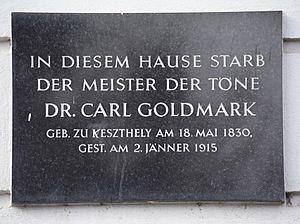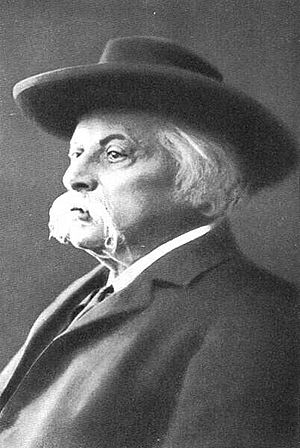Karl Goldmark facts for kids
Karl Goldmark (born Károly Goldmark) was a famous composer from Hungary. He was born in Keszthely on May 18, 1830, and later lived in Vienna, where he passed away on January 2, 1915. He is best known for his beautiful opera Die Königin von Saba (The Queen of Sheba) and his lively Rustic Wedding Symphony.
Contents
Life and Music Career
Early Life and Education
Karl Goldmark came from a large Jewish family. His father, Ruben Goldmark, was a chazan (a leader of prayer and song) for the Jewish community in Keszthely, Hungary, where Karl was born. Karl had an older brother, Joseph Goldmark, who became a doctor. Joseph was involved in the Revolution of 1848 and had to move to the United States.
Karl started learning the violin at a music school in Sopron from 1842 to 1844. Two years later, his father sent him to Vienna to continue his music studies. He studied with Leopold Jansa for about 18 months until he ran out of money.
Becoming a Composer
Goldmark then prepared to enter the Vienna Technische Hochschule and later the Vienna Conservatory. He studied violin with Joseph Böhm and harmony (how musical notes fit together) with Gottfried Preyer.
The Revolution of 1848 caused the Conservatory to close. Goldmark mostly taught himself how to compose music. He earned money by playing the violin in theatre orchestras in Vienna, like the Carlstheater. This experience helped him learn a lot about orchestration, which is how to arrange music for different instruments in an orchestra. He even gave lessons to other musicians, including the famous composer Jean Sibelius.
Growing Fame
Goldmark's first concert in Vienna in 1858 was not well received. He went back to Budapest but returned to Vienna in 1860. To support himself, he also worked as a music journalist. He wrote about both Johannes Brahms and Richard Wagner, which was unusual because most critics at the time strongly supported one or the other. Brahms and Goldmark became friends as Goldmark became more well-known in Vienna.
Goldmark was influenced by Wagner's music. In 1872, Goldmark helped create the Vienna Wagner Society. He was also made an honorary member of important music groups, like the Gesellschaft der Musikfreunde and the Accademia Nazionale di Santa Cecilia in Rome. He also received an honorary doctorate from the University of Budapest.
Famous Works
Goldmark's opera Die Königin von Saba ("The Queen of Sheba"), Op. 27, was very popular during his lifetime. It was first performed in Vienna on March 10, 1875. This opera was so loved that it was performed continuously at the Vienna Staatsoper until 1938. He wrote six other operas as well.
His Rustic Wedding Symphony (Ländliche Hochzeit), Op. 26, was first performed in 1876. This symphony is like a musical story with five parts. It includes a wedding march, a wedding song, a serenade, a conversation between the bride and groom, and a dance.
Goldmark's Violin Concerto No. 1 in A minor, Op. 28, was once his most played piece. It premiered in Bremen in 1877. This concerto is very romantic and includes a Hungarian march in the first part. It reminds some people of music by Dvořák and Mendelssohn. Famous violinists like Itzhak Perlman and Joshua Bell have helped bring this concerto back into popularity.

Goldmark also wrote a second violin concerto, but it was never published. His chamber music, which includes pieces for small groups of instruments, was also well-liked during his time. These pieces show influences from composers like Schumann and Mendelssohn. Some of his chamber works include the String Quintet in A minor Op. 9 and the Violin Sonata in D major Op. 25.
He also composed many concert overtures, which are pieces played at the beginning of a concert. Famous ones include the Sakuntala Overture Op. 13 and the In the Spring Overture Op. 36.
Goldmark's nephew, Rubin Goldmark (1872–1936), was also a composer. He studied with Dvořák and spent his career in New York.
Death
Karl Goldmark died in Vienna on January 2, 1915. He is buried in the Zentralfriedhof (Central Cemetery) in Vienna, where many other famous composers are also laid to rest. Many of his original handwritten music scores are kept in the National Széchényi Library.
List of Works
Operas
- Die Königin von Saba (The Queen of Sheba) (1875)
- Merlin (1886)
- Das Heimchen am Herd (1896), based on Dickens's The Cricket on the Hearth.
- Der Fremdling (1897) (The Changeling)
- Die Kriegsgefangene (1899), (The Prisoner of War) a story from the Trojan War.
- Götz von Berlichingen (1902), based on Goethe's play.
- Ein Wintermärchen (1908), based on Shakespeare's The Winter's Tale.
Symphonies
- Rustic Wedding Symphony, Op. 26
- Symphony No. 2 in E-flat, Op. 35
Works for Orchestra
- Sakuntala, Op. 13 (concert overture)
- Scherzo in E Minor, Op. 19
- Penthesilea, Op. 31 (concert overture)
- Im Frühling (In Springtime), Op. 36 (concert overture)
- Sappho, Op. 44 (concert overture)
- Scherzo in A Major, Op. 45
- Zrínyi, Op. 47 (symphonic poem)
- In Italien (In Italy), Op. 49 (concert overture)
- Aus Jugendtagen (From Youthful Days), Op. 53
Concerti
- Violin Concerto No. 1 in A minor, Op. 28
- Violin Concerto No. 2 (unpublished)
Chamber Music
- Ballad for Violin and Piano, Op. 54
- Piano Quintet in B-flat major, Op. 30
- Piano Quintet in C-sharp minor, Op. 54
- Romanze for Violin and Piano
- Sonata for Violin and Piano, Op. 25
- Sonata for Cello and Piano, Op. 39
- Piano Trio, Op. 33, No.2
- Piano Trio, Op. 4
- String Quartet in B-flat major, Op. 8
- Suite for Violin and Piano in D major, Op. 11
- Suite in A Major for Violin and Piano
- String Quintet in A minor, Op. 9
Piano Works
- Sturm und Drang, nine characteristic pieces, Op. 5
- Three Pieces for Piano Duet, Op. 12
- Hungarian Dances for Piano Duet, Op. 22 (later arranged for orchestra by the composer)
- Zwei Novelletten, Op. 29
- Georginen, six pieces, Op. 52
Choral Works
- Regenlied for unaccompanied chorus, Op. 10
- Two Pieces for unaccompanied men's chorus, Op. 14
- Frühlingsnetz for men's chorus, 4 horns, and piano, Op. 15
- Meeresstille und glückliche Fahrt for men's chorus and horns, Op. 16
- Two Pieces for unaccompanied men's chorus, Op. 17
- Frühlingshymne for contralto, chorus, and orchestra, Op. 23
- Im Fuschertal, a set of six choral songs, Op. 24
- Psalm CXIII for solo voices, chorus, and orchestra, Op. 40
- Two Pieces for unaccompanied men's chorus, Op. 41
- Two Four-Part Songs with piano accompaniment, Op. 42
Lieder (Songs)
- 12 Gesänge, Op. 18
- Beschwörung, Op. 20
- 4 Lieder, Op. 21
- 7 Lieder aus dem 'Wilden Jäger', Op. 32
- 4 Lieder, Op. 34
- 8 Lieder, Op. 37 (Leipzig, 1888 or 1889);
- Wer sich die Musik erkiest (for piano and four solo voices), Op. 42
- 6 Lieder, Op. 46
See also
 In Spanish: Károly Goldmark para niños
In Spanish: Károly Goldmark para niños


